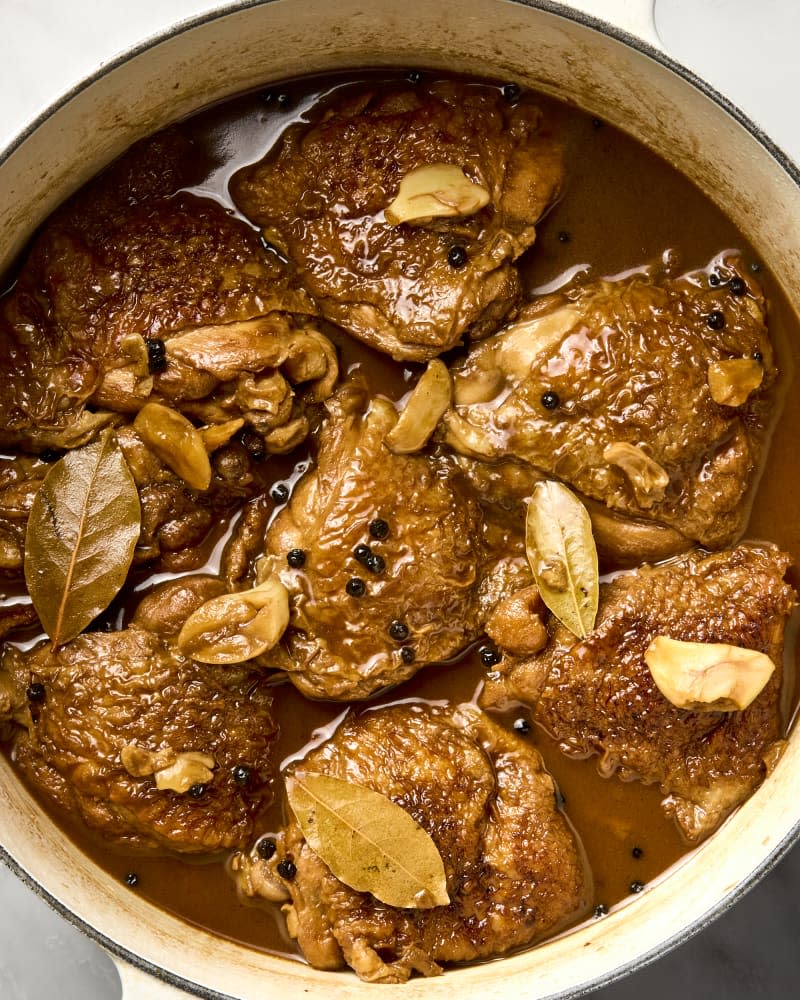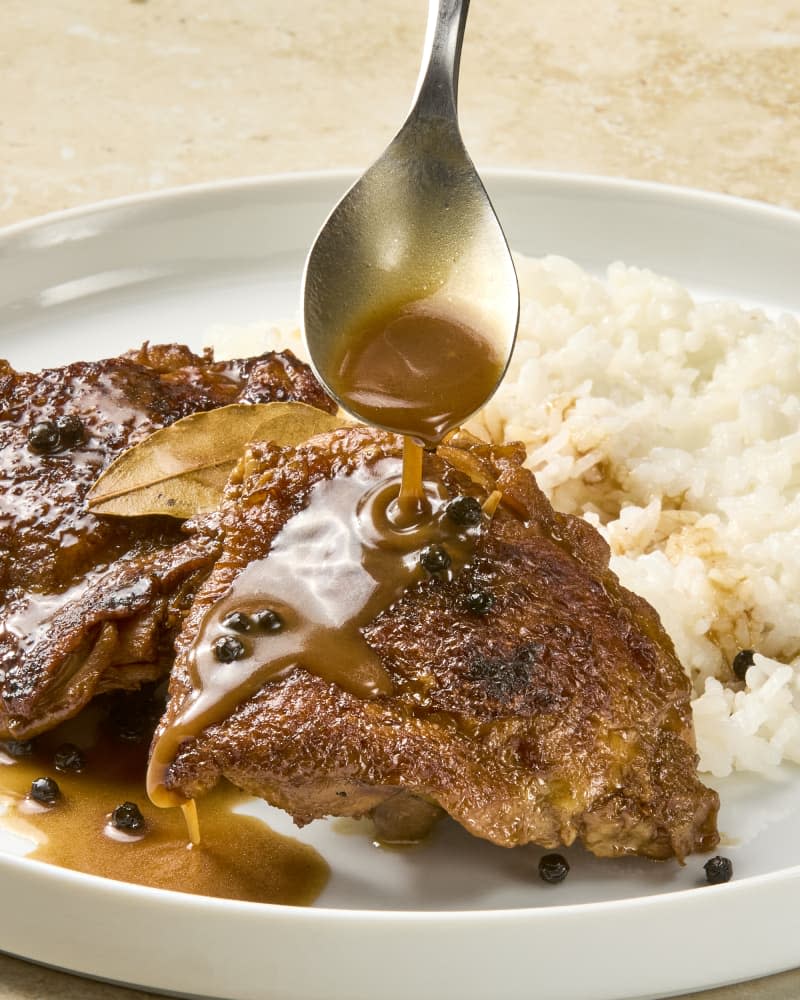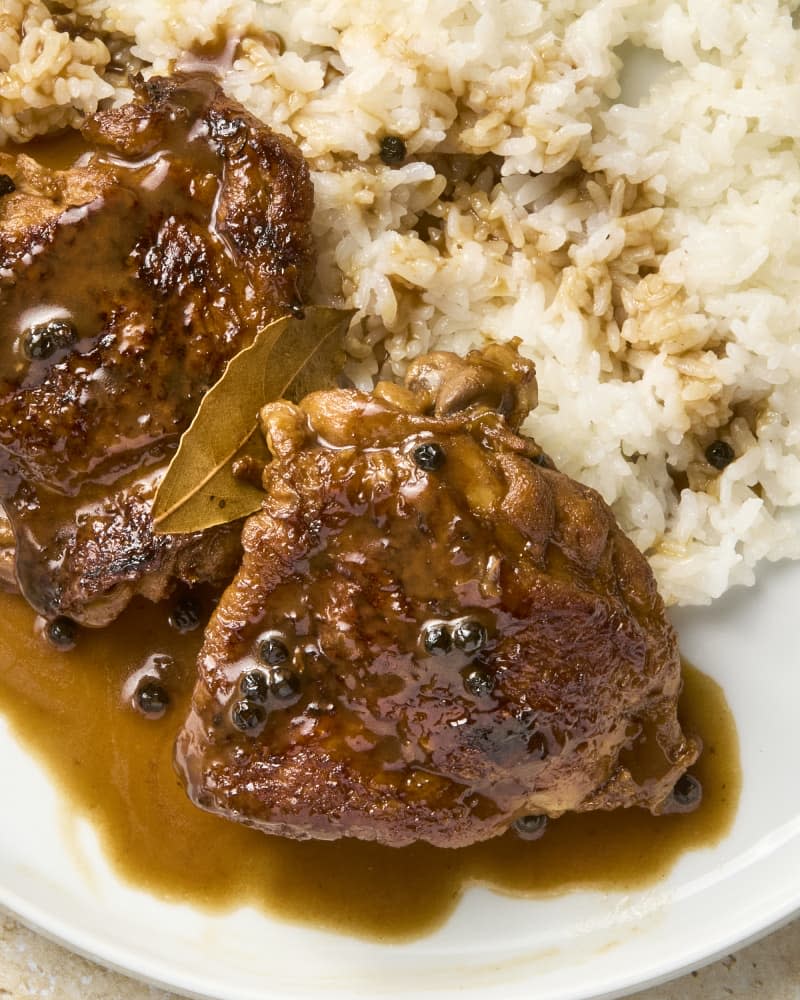My Mom's Filipino Chicken Adobo Is So Good, I Make It for Dinner Every Sunday

I’ve eaten a lot of adobo in my life. Growing up in a Filipino household meant that we ate classic Filipino recipes like adobo, the national dish of the Philippines, on a weekly basis. Sometimes it had chicken, other times it had pork. But regardless of the protein, to me, my mom’s version was always the best — it’s the recipe I go back to again and again.
This is my mom’s recipe through and through, from searing the meat in the pot to the ingenious addition of oyster sauce and then finishing the chicken in the oven. I added just one small tweak: toasting the aromatics in the rendered fat to deepen the adobo’s flavor.
This recipe for Filipino adobo is salty, vinegary, and incredibly easy to make. It’s also a great jumping-off point for making a version of your own that your whole family will adore.
Why You’ll Love It
Browning the chicken in the pan first adds an extra savory flavor to the finished adobo. It’s a step that many other recipes skip, but trust me — it’s 100% worth it.
Toasting the garlic, bay leaves, and black peppercorns in the fat left in the pan helps release their flavors and allows them to permeate the sauce. Again, more flavor!
Oyster sauce is what sets this recipe for Filipino adobo apart — it adds body and an umami-rich flavor that’ll make you want to use up every last bit of the sauce.
The skin is actually crispy! Because chicken adobo is simmered, you usually lose out on crispiness. I solve this by broiling it quickly.

Key Ingredients in Filipino Adobo
Chicken. I’m partial to chicken drumsticks in my Filipino adobo (it’s how I mostly ate it when I was growing up), but it’s equally great with bone-in chicken thighs. You can go all in on one or the other, or use a mix.
Seasonings. Garlic, dried bay leaves, and whole black peppercorns form the flavorful foundation of this dish. I call for 5 cloves of garlic here, but it’s really just a starting point. The same goes for the bay leaves and black peppercorns — you can always add in more.
Soy Sauce. The addition of soy sauce makes this version of adobo (known as Adobong Itim or black adobo) the one most people are familiar with. I keep Silver Swan soy sauce, a Filipino brand, on hand primarily for making adobo. It’s thinner in body, darker in color, and tastes just like home.
Vinegar. Similar to my preference in soy sauce, I recommend using cane vinegar when making adobo. It’s the most commonly used vinegar in the Philippines. Made from fermented sugarcane syrup, its mild flavor perfectly complements the adobo.
How to Make Filipino Adobo
Sear the chicken. Pat your choice of meat dry with paper towels, season with salt, then sear in a Dutch oven (or large heavy-bottomed pot) until browned all over. Transfer chicken to a plate.
Make the adobo. Toast garlic cloves, dried bay leaves, and whole peppercorns in the residual oil, then add water, soy sauce, cane vinegar, and oyster sauce, scraping any brown bits on the bottom. Return chicken to the pot and simmer until cooked through.
Broil the chicken. Place the chicken on a foil-lined baking sheet and broil until browned.
Serve with rice. Pile rice onto a plate, add a chicken piece or two, then drench everything with sauce.

Helpful Swaps
You can substitute rice vinegar or distilled white vinegar for the cane vinegar. The flavor profile won’t be quite the same, but it’ll be delicious nonetheless.
Try swapping in cubed pork shoulder or pork belly, or baby back ribs (like my mom does), for the chicken. Take note that you will need to simmer the meat in the pot covered, and extend the cooking time as needed to ensure that the pork is tender. Once tender, remove the pork from the pot (broil it if you like), and continue to simmer the sauce uncovered to reduce it.
To keep it gluten-free, use tamari in place of soy sauce.
Storage and Make-Ahead Tips
Adobo is one of those dishes that actually tastes better the next day or so. Because the vinegar mellows over time and also acts as a preservative, it can keep in the fridge for up to 5 days. Alternatively, you can freeze your adobo for up to 2 months; thaw in the refrigerator and then warm up in a covered pot over low heat.
What to Serve with Filipino Adobo
More Chicken Adobo Recipes
There are many variations of chicken adobo recipes. Here are more recipes we love.
Filipino Chicken Adobo Recipe
This Mom-approved recipe will wow everyone at the table.
Prep time 5 minutes
Cook time 42 minutes
Serves 4 to 6
Ingredients
5 cloves garlic
3 pounds bone-in chicken thighs, drumsticks, or a combination
1/2 teaspoon kosher salt
1 tablespoon neutral oil, such as canola
3 dried bay leaves
2 teaspoons whole black peppercorns
2 cups water
1/2 cup soy sauce, preferably a Filipino brand like Silver Swan
1/3 cup cane vinegar
3 tablespoons oyster sauce
Steamed white rice, for serving
Instructions
Smash and peel 5 garlic cloves. Pat 3 pounds chicken thighs, drumsticks, or a combination dry with paper towels. Season all over with 1/2 teaspoon kosher salt.
Heat 1 tablespoon neutral oil in a Dutch oven or large heavy-bottomed pot over medium-high heat until shimmering. Working in 2 batches, add the chicken to the pot (skin-side down if using thighs). Sear until browned on all sides, about 6 minutes per batch (reduce the heat as needed if starting to burn). Transfer to a plate.
Place the garlic, 3 dried bay leaves, and 2 teaspoons whole black peppercorns in the pot. Stir until the garlic cloves and peppercorns are slightly toasted and fragrant, 30 seconds to 1 minute. Add 2 cups water, 1/2 cup soy sauce, 1/3 cup cane vinegar, and 3 tablespoons oyster sauce. Scrape up any browned bits from the bottom of the pot with a wooden spoon.
Return the chicken and any accumulated juices on the plate to the pot, arranging the chicken in a single layer (skin-side down if using thighs). Bring to a boil. Reduce the heat to maintain a simmer. Cook uncovered until the chicken registers at least 165ºF in the thickest part, flipping each piece over halfway through, about 20 minutes total. When the chicken is almost ready, arrange a rack in the upper-third of the oven and heat the oven to broil. Line a rimmed baking sheet with aluminum foil.
Using tongs, transfer the chicken (skin-side up if using thighs) to the baking sheet. Continue to let the sauce simmer on the stove. Broil the chicken until browned on top, about 3 minutes. Remove the chicken from the oven, flip each piece, and brush with some of the sauce from the pot. Return the chicken to the oven and broil until browned on the second side, about 3 minutes more. Remove and discard the bay leaves if desired. Serve with steamed white rice and drizzle heavily with the sauce.
Recipe Notes
Substitutions: You can substitute rice vinegar or distilled white vinegar for the cane vinegar.
Make ahead: Adobo actually tastes better made up to 1 day ahead; let cool and refrigerate the sauce and chicken together in an airtight container. Reheat covered on the stovetop over low heat until warmed through.
Storage: Chicken and sauce can be refrigerated together in an airtight container for up to 5 days or frozen for up to 2 months. Thaw in the refrigerator or microwave and reheat in a covered pot over low heat until heated through.

